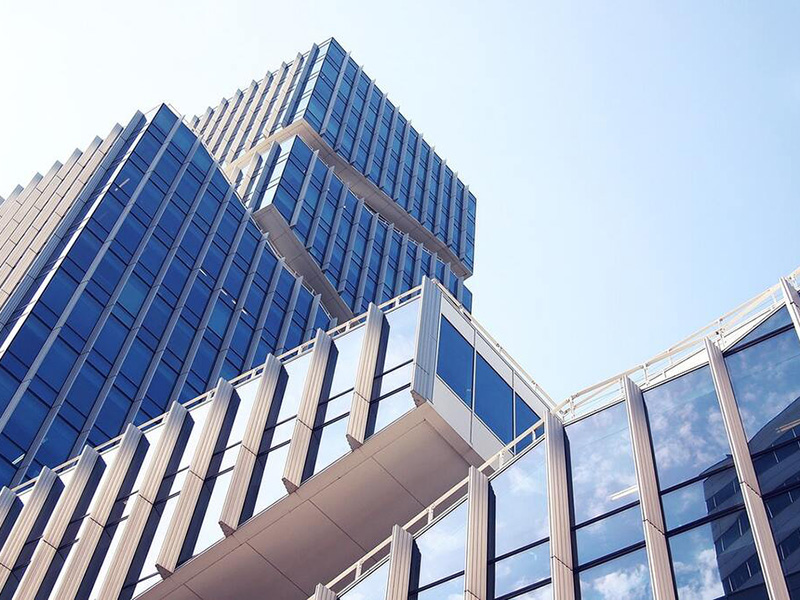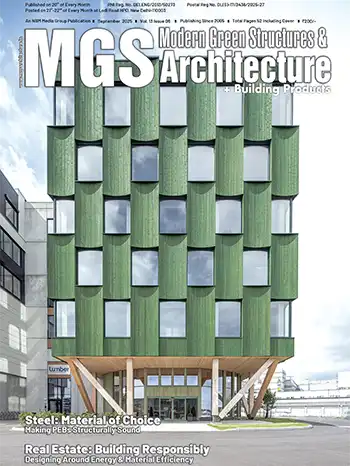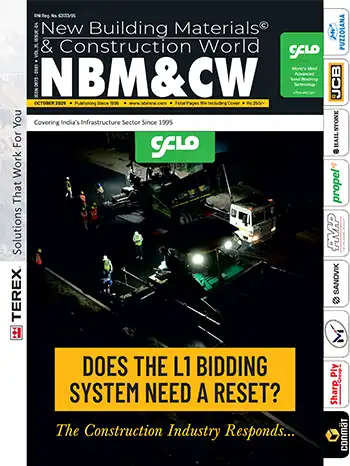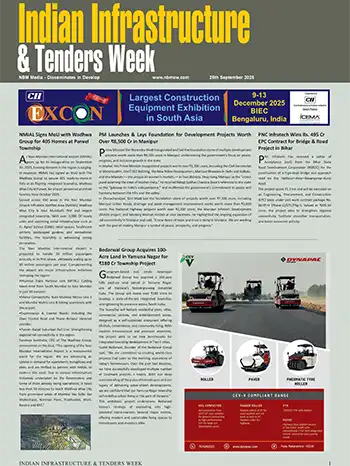
India has no choice but to follow the 'Path of Green' for all future developments in order to ensure a sustainable tomorrow. This in turn offers new opportunities to develop out-of-the-box solutions with new green growth models.
India is witnessing tremendous growth in infrastructural development. The construction sector in India is one of the largest economic activities. Unfortunately, the last 50 years have witnessed many construction industry stakeholders indulging in irresponsible practices, with scant regard for preserving our limited resources. Consequently, our land mass is littered with waste, water bodies are contaminated, and the air we breathe is heavily polluted. With the present government mantra of development and housing-for-all, the construction sector is poised for a quantum leap in the coming decades. Therefore, preserving the environment poses many challenges and at the same time presents excellent opportunities for all stakeholders.
Spearheading the green building movement in India is Indian Green Building Council (IGBC), part of CII. Today, India with over 3.86 billion sq.ft has the world's second largest registered green buildings footprint. IGBC aspires to celebrate 75 years of India's Independence in 2022 with the world's largest, 10 billion sq.ft of green building footprint.
All the 14 IGBC Green Building Rating Systems developed by IGBC encourage professionals to address national priorities in their design and construction. These rating systems have become national by choice and global in performance. IGBC rating systems are enabling the project teams to incorporate some of the finest green building practices, ensuring sustained operational savings through conservation of energy; conservation of water and resources; recycling solid waste; and improving indoor environmental quality. Recycled and recyclable green building products and technologies are gaining increased importance in the building design philosophy. These practices are not only ecologically superior but also economically viable to fulfill our needs.
Stakeholders are incorporating the latest and emerging green building technologies and software tools. These tools & technologies play a catalytic role in reducing the consumption of finite resources, optimizing energy efficiency and addressing ecological issues and concerns. They also improve the ambient air conditions, enhance occupants comfort and double up safety & security of the building. IGBC Green Building rating systems encourage project teams to adopt energy modeling & other software techniques, to explore various design options, material specifications, equipment, and control systems.
Many of the leading green building manufactures are active members of IGBC. They are working closely with the stakeholders in developing innovative and futuristic materials and technologies, which are playing a vital role in ensuring that green building standards are met and adhered to by stipulation. Many new materials and services have been introduced in India as a result of this movement. IGBC estimates that the market potential for green materials and technologies would be about USD 300 billion by 2025.
Top10 Green Innovations in the building sector
- Autoclaved Aerated Concrete (AAC) Blocks with sandwiched Insulating Board
Green building projects have encouraged use of autoclaved aerated concrete blocks and also insulation boards for enhancing the thermal properties of wall. Recently, insulating board and auto calved manufactures have come together to launch blocks with dovetailed insulating board.
These offer the following advantages.- Enhanced thermal properties
- Reduced time and cost required for external wall construction.
- Better 'U' value and much low energy bills.
- High Performance Glass
Many projects are already using double-glazed units (DGU) to cut down heat ingress into conditioned spaces. The next generation development is the use of triple-glazed units which would approach the thermal properties of a conventional brick wall.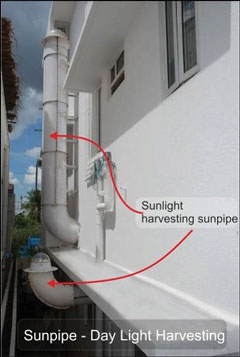
These high performance glass units are also provided with low emissivity (Low e) glass and are called transparent wall. These high performance glazing units bring in excellent day lighting into office spaces, with practically no heat ingress into conditioned space. This provides an opportunity to design and build homes/offices, which are completely day-lit, and yet require minimum air conditioning.
High Performance Glass offers the following benefits:- Substantially reduction in air-conditioning load
- Enhanced day-lighting
- Enhanced outdoor views for occupants, to connect to external world
- Faster Construction
- Light Pipes
Light pipes or sun pipes are used for transporting or distributing natural or artificial light. Providing daylight in spaces such as basements or non-peripheral areas of building, has always been challenging. Technological advancements such as light pipes provide light during the daytime, without any dependency on artificial lighting,, thereby bringing down the power bills.
Light pipes offer the following benefits- Allow day light to transport to deep interior locations
- Minimise the use of artificial light and save energy consumption
- Significant contributor to green homes
- Pre-fabricated buildings
The concept of pre-fabricated structures is gaining importance in green residential, industrial and commercial buildings. Buildings are tailor-made to suit the requirements of the occupants with a minimum of on-site construction.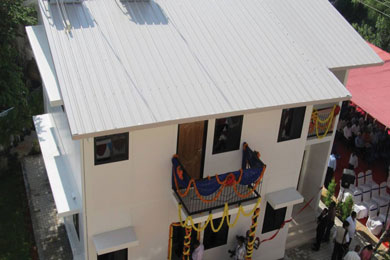
Benefits of pre-fabricated buildings include- Reduction in cost of construction
- Speedy completion of projects
- Elimination of construction waste
- Reduction in out-door pollution
- Usage of flyash / slag based concrete walls
Many of the high rise residential and commercial office projects in the country have started using fly-ash / slag (post industrial waste) based concrete walls which uses the industrial waste like flyash from coal based power plants and slag from steel manufacturing facilities.
Flyash flag based concrete walls offer the following benefits- Enhanced thermal property
- Beneficial use of industrial waste
- Reduced demand for virgin materials
- Reduced construction time, when compared to a conventional building
- Much lower cost of construction.
- Building Integrated Photo Voltaics (BiPV)
BiPV systems are used to replace conventional building materials in parts of the building envelope, such as the roof, skylights, or façade; also generate renewable energy. This is considered as one of the best solutions for projects which have space constraints for installing on-site renewable energy systems..
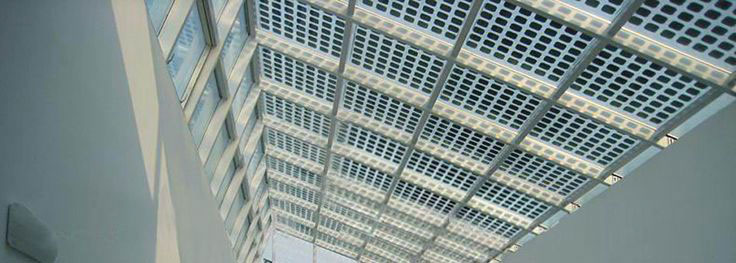
Benefits of BiPV include:- Saving in materials & electricity costs
- Reduced use of fossil fuels
- Net Zero Energy Buildings
Net Zero Energy Buildings (NZEB) are buildings where the net annual energy consumption and carbon emissions, are zero. In NZEB, energy is usually harvested on-site through a combination of energy producing technologies, like solar & wind, while reducing the overall use of energy through highly efficient HVAC & lighting technologies. - Bamboo based Furniture (Rapidly Renewable Material)
Use of Bamboo is becoming increasingly popular as an alternative to conventional wood such as timber & teak. It is regarded as a rapidly renewable resource because of its exceedly fast harvesting cycle. Most of the timber materials require about 30-40 years for maturity, whereas, bamboo can be harvested within a cycle of 3-5 years. - Geothermal Systems
A geothermal system is a renewable heating and/or cooling system that pumps heat to or from the ground crust or form the subterranean water. This system takes advantage of the moderate temperatures in the ground or water to boost efficiency and reduce operational costs of heating and cooling systems. - Building Management System
A Building Management System (BMS), is a computer-based system that monitors and controls the building's mechanical and electrical system components, such as mechanical ventilation, lighting, power systems, fire systems, and security systems. BMS provides monitoring on a continuous basis in response to the usage pattern to ensure smooth running operation.
Conclusion
Green Buildings are the need of the hour. Concerted effort has to be made to ensure that green buildings again become the "Way of Life". With construction in India projected to grow exponentially in the coming decades, green buildings offer the win-win solution. The focus has to be on promoting sustainable built environment.IGBC foresees that the next 10 years will be the decade of integrated sustainable built environment. This will mostly be in the form of large integrated townships, satellite cities, gated communities and campuses with multiple buildings. This development presents an enormous opportunity to design the projects as green from day one and influence the way of life of occupants. The place we live, work, study, play and commute should all go the green ways. All the innovative and futuristic technologies will facilitate a greener and healthier India.










